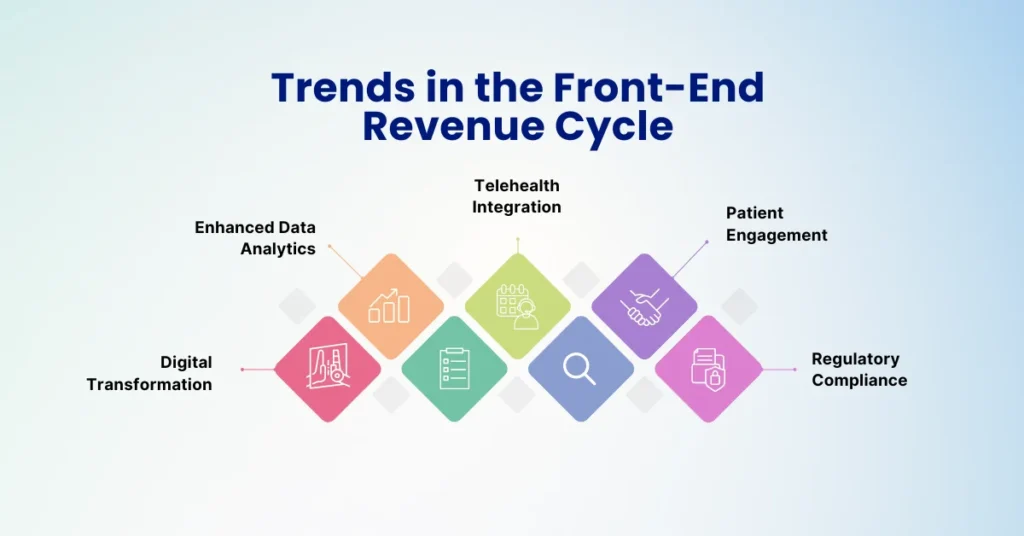The healthcare revenue cycle comprises three phases: the front-end, mid-cycle, and back-end. While revenue cycle leaders pay considerable attention to mid and back-end functions like coding, billing, claims management, and denials management, it’s essential to recognize that actions taken before a clinical encounter can significantly influence revenue cycle efficiency. Optimizing front-end processes, particularly scheduling, is a critical aspect of a provider’s financial success.

Front-End Revenue Cycle: The Foundation of Financial Success
Front-end revenue cycle processes encompass vital tasks ensuring accurate and timely revenue generation. These include:
Patient Registration: This step involves collecting essential patient information, contact details, insurance data, and necessary authorizations or consent forms.
Scheduling and Appointment Management: Efficiently booking appointments and managing patient visits’ timing ensures correct billing of services and that the right clinicians see the patients. Proper scheduling also involves referral management, ensuring that patients receive the necessary specialist care when required.
Insurance Verification: Verifying each patient’s insurance coverage and benefits is crucial to avoid claim denials and billing complications..
Prior Authorization: In some instances, medical procedures or treatments require prior authorization from the patient’s insurance company. Front-end staff may need to collaborate with physicians to obtain these authorizations before providing the medical services.
Co-Pay and Deductible Collection: Front-end staff collect co-pays or deductibles before or after services are provided, ensuring patients contribute their share of healthcare costs.
Financial Counseling: Helping patients navigate the financial aspects of their medical care, including insurance coverage, financial assistance, payment options, and cost estimation, enhances price transparency for patients.
Effective execution of these front-end revenue cycle processes is pivotal for accurate and timely revenue collection, streamlining the revenue cycle, minimizing billing errors, and maintaining the overall financial health of healthcare institutions.
Trends in the Front-End Revenue Cycle
The landscape of front-end revenue cycle processes is evolving in response to changing healthcare dynamics. Several trends are shaping this critical aspect of financial management for healthcare providers:

Digital Transformation: Healthcare institutions increasingly adopt digital tools and platforms to streamline front-end processes. Digital pre-registration, patient portals, and online appointment scheduling enhance patient engagement and reduce administrative burden.
Enhanced Data Analytics: Data-driven decision-making is becoming more prevalent in front-end operations. Advanced analytics help providers identify patterns, optimize scheduling, and improve patient interactions.
Telehealth Integration: The rise of telehealth services has necessitated changes in front-end processes. Scheduling now encompasses virtual visits, requiring providers to adapt and efficiently manage in-person and remote appointments.
Patient Engagement: Front-end staff play a more significant role in patient engagement. They educate patients about insurance, payment options, and price transparency, ensuring they are well-informed and satisfied with their healthcare experience.
Regulatory Compliance: Keeping up with changing regulations and compliance requirements is an ongoing challenge. Front-end processes must adapt to protect patients’ data privacy and financial information.
Incorporating these trends into front-end revenue cycle optimization efforts is essential for providers seeking financial success in a rapidly evolving healthcare landscape.
Key Strategies for Optimization
Front-end revenue cycle issues, primarily tied to registration, eligibility, and authorization, contribute to nearly half of the claim denials, as per “The Change Healthcare 2020 Revenue Cycle Denials Index.” Healthcare organizations must prioritize front-end revenue cycle optimization to prevent reimbursement delays and claim denials. Here are key strategies, including outsourcing, for achieving this:
Regulatory Compliance: Ensuring front-end staff can effectively communicate with patients to obtain accurate billing information is crucial. Additionally, staff should understand insurance policies and be able to explain the costs of care and payment options.
Automation: Automating front-end revenue cycle processes can reduce errors and improve efficiency. Digital pre-registration, patient portals, self-service kiosks, and automated insurance verification tools streamline processes, minimizing manual data entry and potential mistakes.
Digital Payment Options: Implementing digital payment options enhances point-of-service cash collections, providing patients with convenient payment methods and improving their overall experience.
Outsourcing: Healthcare providers can partner with specialized outsourcing firms that excel in front-end processes. Outsourcing offers several benefits:
Expertise: Outsourcing firms have dedicated teams with expertise in front-end revenue cycle management. They stay updated with industry trends, regulations, and best practices, ensuring efficient operations.
Scalability: Outsourcing allows healthcare providers to scale their front-end operations according to demand. During peak periods, the service provider can quickly deploy additional resources and optimize staffing during quieter times.
Cost Efficiency: Outsourcing can often be more cost-effective than maintaining an in-house team for specific tasks. Providers can reduce expenses associated with staff recruitment, training, and benefits.
Focus on Core Competencies: Outsourcing front-end processes enables healthcare providers to concentrate on their core competencies, such as patient care and clinical excellence, while specialists manage the revenue cycle.
Risk Mitigation: Outsourcing firms are well-equipped to handle compliance and regulatory challenges, reducing the risk of costly errors and penalties.
By adopting these strategies, healthcare organizations can optimize their front-end revenue cycle processes, reduce costly errors, enhance the overall financial health of their institutions, and maintain their focus on delivering high-quality patient care.

